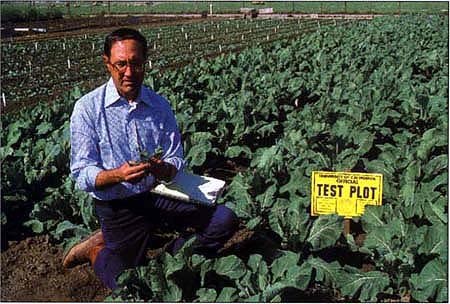All Issues
Q & A: Harry Agamalian, Monterey County farm advisor
Publication Information
California Agriculture 50(6):32-33.
Published November 01, 1996
PDF | Citation | Permissions
Abstract
Harry Agamalian is a pioneer in the discipline of weed science. He joined the Monterey County UC Cooperative Extension in 1955 as an agronomy farm advisor, but soon advanced to become the county's first weed science advisor. He began working with weeds when the first herbicides were being developed, a time of dramatic change in the agricultural industry. Agamalian earned a bachelor's degree in agronomy from UC Davis in 1955 and a master's degree in weed science from the University of Arizona while on sabbatical leave in 1964. Agamalian retired in 1991; however, he has continued his research and extension activities as an advisor emeritus.
Full text
In 1946, when California Agriculture was first published, California was entering a post-World War II era of optimism and prosperity. UC's College of Agriculture (the predecessor to the Division) was on the brink of a great expansion. As you remember that time, what did society expect from the College of Agriculture?
HA: Society expected good, wholesome, bountiful supplies of nourishing food. Returning veterans were going to college, people were getting married, starting families. They had good incomes, finally, after coming out of the depression and surviving shortages during World War II. The public had seen scientific endeavors put to use in the War Machine. Now, they were looking for the scientific accomplishments to enrich their lives.
Right after the war, the principal means of weeding was mechanical or hand weeding. California relied on the Mexican Bracero program for cheap labor. In the late '50s, we began working with two or three herbicides, demonstrating their safety and having field tours. But growers would come up and say, “Harry, they look good, but I can weed and thin my lettuce field for $25 an acre, why would I spend $30 an acre for herbicide?” Then we lost the Bracero program and farmers just flocked to our office. Suddenly they didn't have this abundant, cheap labor force but we had good information for them on herbicides. Farmers weren't ready for it earlier, but now we were ready for them.
How did those expectations change in subsequent decades and what are they today?
HA: The agricultural community still sees the University in a leadership role in agricultural technology development. As we went into the '70s, the private sector became more of a working partner with public agencies. The University never developed pesticides, but we put the package together. We helped develop systems that considered all aspects of agricultural production.
Also, in the latter part of my career, our clientele started to shift to a group that was secondary extenders of our information, whereas back in the '50s and '60s, we were talking directly to farmers and farm managers.
How did you perceive your role as an advisor when you were hired in 1955? How did your job change over the years?
HA: Farm advisors throughout the state were commodity oriented. We were looked at more as educators than as researchers. Some believed farm advisors weren't capable of research, that we weren't all that sophisticated. We only did demonstrations and field tours. The role changed in the '60s and educational requirements for the job increased. We started doing applied research. There was such a flood of new technology, the Experiment Station couldn't cope with it all. Today, research is the primary mechanism for an advisor to get promotions. I believe the California agricultural industry benefited tremendously from the change.
What were UC's most significant research and extension contributions during these years, particularly in your area of expertise or to the industry you served?
HA: In the 1960s I thought, perhaps naively, we were helping mankind by getting rid of this burdensome task of hoeing weeds. Weeding was always the lowest paid and most laborious task in agricultural production. Of course, we weren't the originators of herbicides, but since we were the ones who did the field testing, we contributed as objective evaluators of privately developed information. Today I believe our most significant contribution was establishing a use pattern of selective herbicides in vegetable crops and educating growers on how to use them properly and safely.
How have societal changes over the last 50 years influenced the Division?
HA: The environmental movement had a great impact. A lot of us felt we were adhering to good scientific procedures, but society began looking over our shoulders. It triggered revisions of the procedures for getting pesticides registered. During the '40s, '50s and '60s, people wanted plenty of inexpensive food. Later they began questioning, “How safe is my lettuce?” The University had to become responsive to an audience that wasn't a traditional one. As consumer groups became more inquisitive about how food was being grown, we made a strong attempt to educate those components of society.
Looking toward the future, what is the most important task for the Division and for UC?
HA: I've never been a good crystal ball guy. We sometimes talk in small groups and raise the question, “What is the future of public research as opposed to private?” In pest management, I think the University still has a strong role in looking at systems and developing procedures or programs. We have the ability to look at the total picture when using a pesticide: What's happening to predators? What effect does it have on the soil and on the crop? Recently, the University has gotten involved in larger issues — water issues, effluent issues, land-use issues. We're putting task forces together to come up with programs that legislators can adopt or that will influence decision makers. But I think we will always be involved in the nuts and bolts of agriculture. We should continue to serve as an objective body for interpreting scientific knowledge for growers and consumers.





